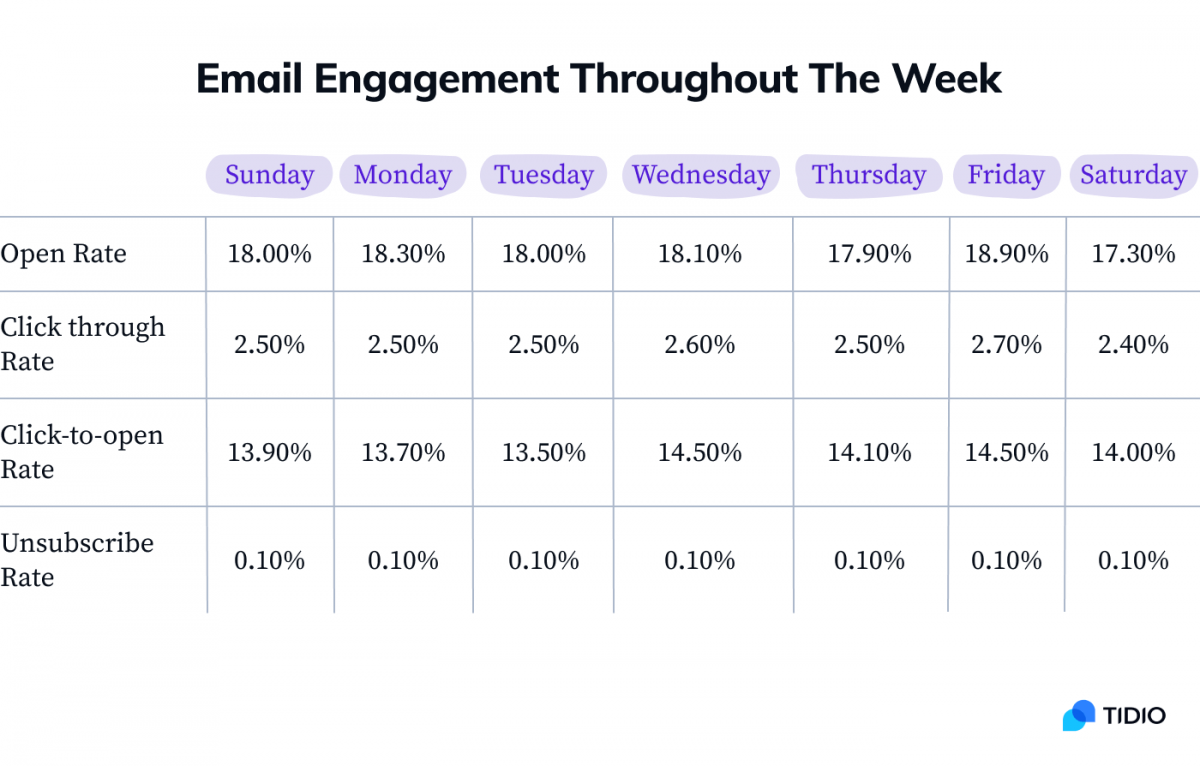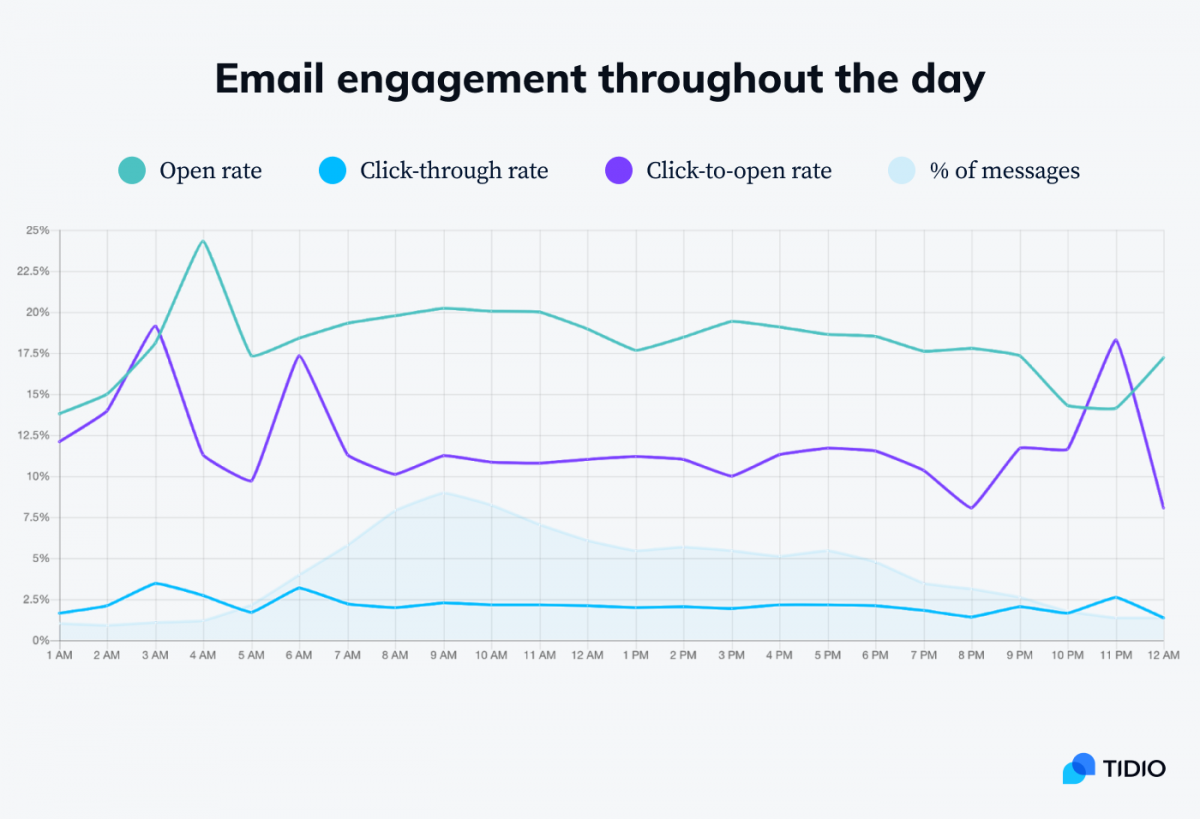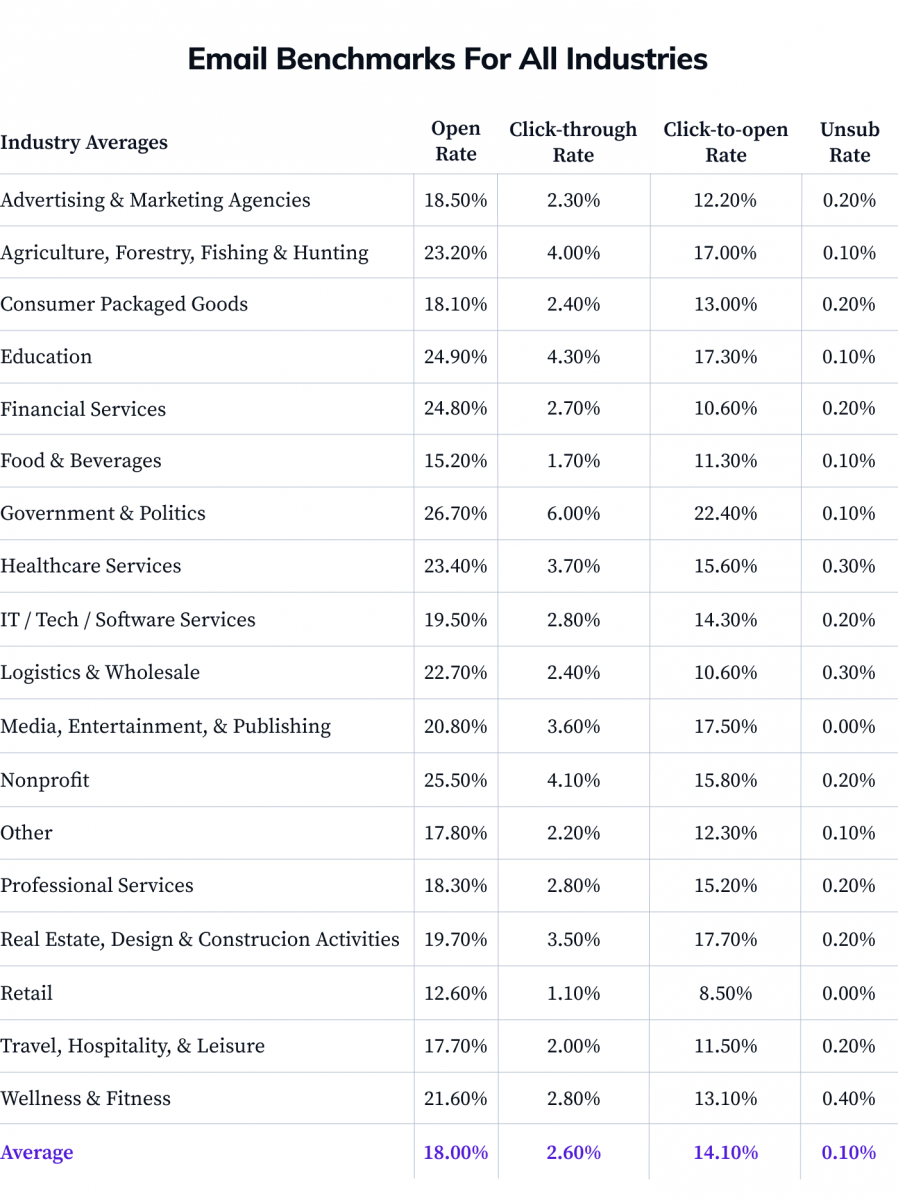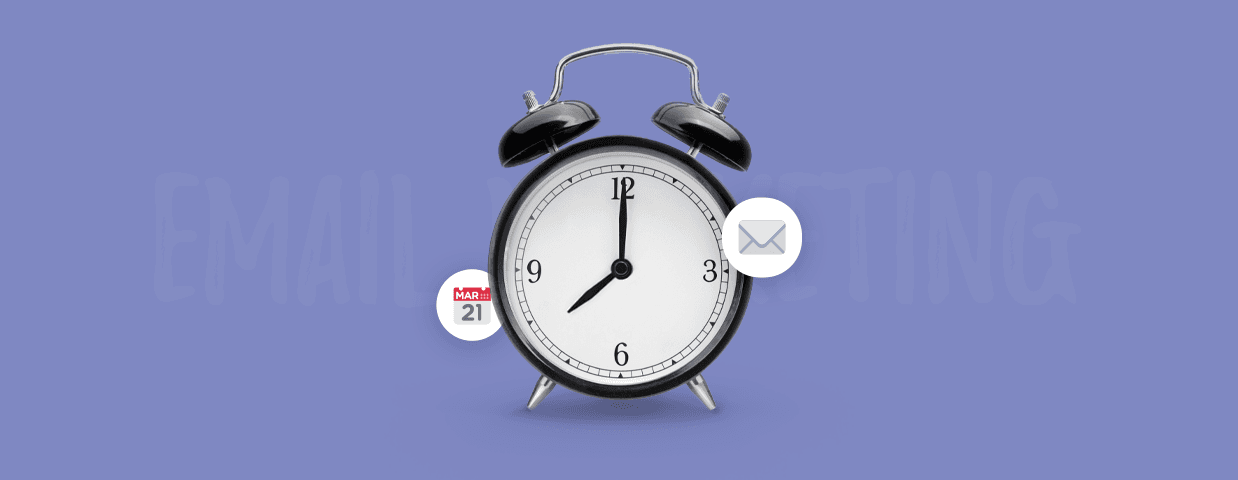The answer is 3-7 AM.
While many outdated articles suggest that 10 AM is the golden spot, the latest research reveals that the best time to send emails is exactly between 3 and 7 AM.
Another notable time is between 8 PM and midnight. We bet you didn’t expect that! Well, it seems that in 2023, people like to read emails in the early mornings and late evenings.
The question is—
Why doesn’t everyone send their emails at these times? Well, because they don’t work for everybody.
And that’s what brings you here, isn’t it?
In this article, you’ll learn:
- Which times work best on weekdays, weekends, and holidays
- How to figure out the best time windows for your audience
- Tips and tricks to increase your email open rates
- How to measure email marketing KPIs the right way
Get more contacts on your mailing list and engage clients with marketing bots
Want to explore other email-related areas? Have a look at these articles:
- 25 Customer Service Email Templates [+Best Practices]
- 5 Easy Steps to Build an Email List from Scratch [for Free]
- How to Create a Professional Email Signature [Tips & Examples]
- 10 Best Email Marketing Templates [Free Download]
- How to Write Email Subject Lines to Boost Open Rates [Examples]
- Free Email Newsletter Templates & Examples
- 20+ Best Email Opening Sentences & Greetings [Email Starters]
- Professional Email Header Design: 7 Best Practice Examples
- How to Write a Professional Email [Email Format & Examples]
Why Email Marketing Is Crucial For Your Business
Every time you find yourself dissatisfied with your email blasts’ open rates, don’t get into the whole “email marketing is dead” mindset. Instead, have a look at these facts:
- Email marketing is still one of the most effective ways to speak to your audience, with its reach 40 times more effective than any social media, according to a McKinsey study.
- As reported by Adobe, nearly 50 percent of US-based consumers prefer to receive marketing offers via email, compared to other media.
- Automated email marketing campaigns have the potential to increase your sales even by 14% (!).
Based on the above data, you can say that email campaigns remain one of the most powerful digital marketing tools.
It’s important to note, though, that only the right email messages delivered at the right time have the power to engage your audience and help your business grow.
To the point—
Days of the Week and Times of the Day
Use the following data as a reference point if you have limited knowledge about your target audience.
Business Days
Business days have the highest engagement rate. They comprise 85% of the total open rate weekly volume and gain nearly 95% of the weekly clicks. The latest data shows that Friday is the winner in the total open rate volume (18.9%), click-through rate (2.7%), and click-to-open rate (14.5%).

The second-best day to send promotional emails is Monday with an 18% open rate and 13.90% click-to-open rate.
Thursday takes the cake in terms of open rate, while Tuesday emails get the lowest click-to-open rate.
The study also reveals that Saturday has the lowest email open rate (17.3%) as well as click-through rate (2.4%), which makes it the worst time to send emails. The unsubscribe rate remains the same throughout the whole week.
What about the best times of the day?
The highest click-to-open-ratio (CTOR) and click-through rate (CTR) happen between 3 AM (19%) and 7 AM (17%).

Good to know…
CTOR is the number of unique clicks divided by unique email opens, whereas CTR shows the percentage of users who clicked on any link (including an image) within an email. Both metrics show how interested your subscribers are in the content you share.
At first, it might seem a bit strange that the spikes appear during the late evening and early morning, but when you think about it, these timings reflect people’s new daily routines.
During the pandemic, a lot of people work flexible hours, which means they sometimes work late or start work very early to spend time with their families during the day.
The spike observed around 11 PM also seems to confirm that people might be browsing their inboxes to get ready for work the next day.
Want to send beautiful newsletters and email marketing campaigns right on time? Try our free email marketing software to create and schedule your emails quickly.
The open rates, on the other hand, are high at 4 AM (25%) and then oscillate around 20% throughout the whole day and decrease to 15% around 10 PM.
This means that there are generally two popular time slots during the day when recipients are most engaged:
- Early morning (even as early as 4-6 AM)
- Late evening until 10-11 PM
Avoid sending emails past 12 AM. After that hour, CTOR sharply drops. It means that your recipients will not read your email immediately and by the time they recheck their mail, your email will already be sitting at the bottom of their inboxes.
Keep in mind that these numbers might be completely different for your target audience. In this case, you may need to adjust your sending times to fit their routine.
What about the best times to send emails on non-business days?
Weekends
Saturdays and Sundays receive a decent amount of click-to-open rates (respectively 14% and 13.90%), but Saturday has also the lowest email open rate (17%) and click-through rate (2.4%).
This makes the weekend the worst performing time for email sending.
…or does it?
Remember that entrepreneurs and executives in the B2B sector tend to check open emails more frequently.
It turns out that the best time to send B2B emails is actually during the weekend; specifically on Saturday at 10 AM (for open and click-through rates), whereas the best time to send email blast for B2C sector is Saturday at midnight.
Holidays
Holidays can be one of the best times to send email blasts because many people are looking for bargains (for example, at the beginning of the Christmas season).
There is one “but” though—
As all businesses get their marketing efforts into full swing, you need to remember that you will not be the only one sending emails to people from your contact list.
Holidays are also more tricky as they don’t follow the typical email sending times that apply to regular weekdays or weekends.
When should you send holiday emails? Le’s go through data and see how major holidays affect email marketing sending times.
Black Friday
The time to start sending out BFCM (Black Friday and Cyber Monday) email blasts is immediately after Halloween. Customers who are interested in bargains will want to see Black Friday marketing specials a week or two before the big day.
When it comes to the number of emails, it’s a good practice to send an email once or twice a week to gently build up anticipation.
And if this approach does not fit your business strategy, you can email your subscribers shortly before Thanksgiving Day. Remember not to wait too long, though. If you send out the first newsletter on Black Friday, most likely you won’t see any results.
The best time with high open rates is around 12 AM—people browse their inboxes on mobile devices at that time and are more likely to open marketing mail.
Check out our Black Friday Phrases & Marketing Guide to plan your BFCM email campaign!
Read more: Check out the most important Black Friday stats to better prepare for your BFCM campaigns.
Christmas
The first and second weeks of November are considered the best times to start sending pre-Christmas email campaigns.
During the Christmas season, open rates fall sharply on December 22, and that trend continues until the start of the New Year.
The click-through rates are at an all-time high, with a decline on Christmas Eve and Christmas Day. You may also want to send an after Christmas newsletter blast to capitalize on post-Christmas sales. The best practice is to send your holiday email marketing campaign during evening hours, to avoid competition.
New Year
The best time to send marketing emails is after the holiday craziness has cooled down a bit.
As open rates remain low throughout the beginning of the New Year, the engagement slightly increases between January 5 and January 8. This makes it the perfect time for email marketers to send email newsletters foreshadowing new products or services.
What about other holidays like Valentine’s Day, Labor Day, or St. Patrick’s Day? These holidays do not see too much change from the usual trends, so you can conduct your business as usual.
But When to Send Emails to YOUR Audience
It would seem Friday and Monday are the best days to send out an email campaign.
Yet—
Those findings do not work for every audience all over the world. Some eCommerce owners might find that the best time to send business emails is mid-week, whereas workdays might not get the highest open rates for real estate companies.
Not to mention that if you decide to follow the “recommended” best times and days, you will face a lot of competition that chose to follow the same lead.
The best thing you can do is dig deeper and discover the most optimal sending times for your campaigns.
To do this, use what you have just learned to fine-tune the “best days and times” to work with your recipients.
Send Emails at the Times Suggested by Research
You already know what works for most email marketers across multiple industries, which is a solid starting point for gathering your insights.
First, schedule your emails to go out in the early morning or late evening on weekdays. You may start by sending your campaigns at 5 AM on Mondays and 10 PM on Fridays.
Split your audience into two groups (A and B) and send them the same campaigns but on a different day of the week or time of day to see which campaign will receive a higher open rate.
Compare Your Data
Check your data to see how many opens and clicks-through your emails received. Are the numbers different from what you expected? How far are they away from your industry average?

The comparison will reveal how much optimization your email marketing strategy needs.
A/B Test, Iterate, and Optimize
Even if your initial results are lower than you hoped for, keep on testing. You are gaining insights that can help you set your own email marketing benchmarks.
If you are not getting the email open rates or clicks you wanted to see, start testing different sending times and days.
The best practice is to always test one variable at a time. Otherwise, you will not know which one needs improvement.
Understand Your Audience
Make sure you understand the needs of people on your email list. Knowing your email subscribers better will help you tailor your email times to their schedules.
For example, if you target young people who have their mobile phones glued to their palms, there is a chance that late evening emails will work for them.
Similarly, if you are in the entertainment sector, you could email your recipients on Saturday morning to suggest some cool ideas to try during the weekend.
Be Consistent
Email marketing is a process rather than a single event. So when you finally discover the best timing, stick to it and send your messages regularly.
Consistency may help you develop a habit for your recipients to expect an email from you at a particular time.
Low Conversion Rates? Test Other Variables
If your desired metrics are still low despite having tested several time slots, perhaps there are other things you should also look into.
Remember, test one variable at a time.
Time-Zones
Adjust your email send times to your recipient’s time zone. You may need to split your larger customer segments into smaller ones to ensure that each of your readers will receive the newsletter simultaneously in their time zone.
Content
Are the emails you’re sending relevant to your subscribers? Or perhaps some contacts on your list are no longer interested or need some re-engagement campaign?
Consider everything you know about your subscribers and how this can be related to your business. Try answering a few questions first:
- What are your customers’ demographics?
- What do your subscribers do for a living?
- What do they like to do on weekends?
- How can they use your product or service?
- What are their needs and problems?
- How will your email help them?
For example, big families and people who don’t work full time have different needs that influence their disposable income and free-time activities.
After all, maybe it’s not so much about wrong timing as the value you’re offering (or the lack of it).
Marketing Goals
What do you want your audience to do when they receive your email?
- Open and read (e.g., educational content)?
- Click through (e.g., promotional content)?
- Convert (e.g., special deals or coupons)?
Your goal determines content, your content impacts your recipients’ engagement, the engagement reflects your metrics.
Here are three types of goals that will influence your sending times:
- Long engagement: If you expect your audience to devote more time to your email, send it during less popular or busy time slots—for example, Friday afternoon, evening, or weekend evening.
- Short engagement: If your goal is to keep your brand fresh in their heads, a quick informative email sent anytime on a business day will do.
- Quick reminder: If you want to remind your recipients about something, send one email a day before an event and another one hour before the event starts.
Email Subject Lines
Subject lines play a huge role in email marketing. From the email open rate point of view, they are even more important than the email copy itself.
That’s because it’s the subject line that makes your subscribers open your email in the first place. Invest some time and effort in creating attractive subject lines. The effort will pay off!
If writing creative subject lines is not your strong point, check out our post on the best email subject lines to increase open rates.
Key Takeaway
So, here’s what you need to know about the best times to send emails:
- The most popular times to send email campaigns are Monday and Friday.
- You can use that knowledge as a starting point to discover the best times to send emails that work for your unique audience.
- Send times during major holidays play by different rules.
- There is no one-size-fits-all answer when it comes to the best send time for every business sector.
- The content of the email, marketing goals, subject lines will determine the best email send times for a particular campaign.
- You can use an email marketing service (like Tidio, Hubspot, Getresponse, Mailchimp, or Wordstream) that allows you to segment, test, and compare your campaigns.
If you feel inspired to create and send an email newsletter, and need some help, don’t hesitate to reach out to us—we will gladly help you send out your first email blast!
Get more contacts on your mailing list and engage clients with marketing bots

